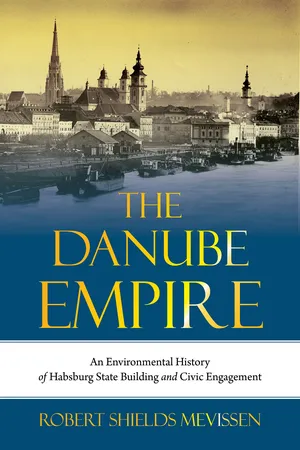
eBook - ePub
The Danube Empire
An Environmental History of Habsburg State Building and Civic Engagement
- English
- ePUB (mobile friendly)
- Available on iOS & Android
eBook - ePub
The Danube Empire
An Environmental History of Habsburg State Building and Civic Engagement
About this book
In the nineteenth century, changes to the environment, driven by ideology, natural forces, and burgeoning fossil fuel power, shifted the course of the Habsburg Empire. Along the Danube—Europe's second longest river—hydraulic engineering projects ranging from bridges to embankments and shipping hubs affected the river's dynamics, as did new activities related to trade, industrialization, sanitation, recreation, and agriculture. Taking a unique environmental perspective to explore questions of transnational solidarity and identity, The Danube Empire argues that the Danube River served as both a catalyst and a tool for institution building. Drawing on primary sources in German and Hungarian, Robert Shields Mevissen reconstructs how various communities throughout the empire viewed and shaped river engineering works as a means to promote material wellbeing and economic vitality. As they negotiated their conflicting and overlapping interests, they engaged government at all levels, from the imperial to the local, through democratic and civic avenues. Offering new insights into the state's normative development and robust civil society, Mevissen shows how an empire, in reshaping a river, reshaped itself.
Frequently asked questions
Yes, you can cancel anytime from the Subscription tab in your account settings on the Perlego website. Your subscription will stay active until the end of your current billing period. Learn how to cancel your subscription.
At the moment all of our mobile-responsive ePub books are available to download via the app. Most of our PDFs are also available to download and we're working on making the final remaining ones downloadable now. Learn more here.
Perlego offers two plans: Essential and Complete
- Essential is ideal for learners and professionals who enjoy exploring a wide range of subjects. Access the Essential Library with 800,000+ trusted titles and best-sellers across business, personal growth, and the humanities. Includes unlimited reading time and Standard Read Aloud voice.
- Complete: Perfect for advanced learners and researchers needing full, unrestricted access. Unlock 1.4M+ books across hundreds of subjects, including academic and specialized titles. The Complete Plan also includes advanced features like Premium Read Aloud and Research Assistant.
We are an online textbook subscription service, where you can get access to an entire online library for less than the price of a single book per month. With over 1 million books across 1000+ topics, we’ve got you covered! Learn more here.
Look out for the read-aloud symbol on your next book to see if you can listen to it. The read-aloud tool reads text aloud for you, highlighting the text as it is being read. You can pause it, speed it up and slow it down. Learn more here.
Yes! You can use the Perlego app on both iOS or Android devices to read anytime, anywhere — even offline. Perfect for commutes or when you’re on the go.
Please note we cannot support devices running on iOS 13 and Android 7 or earlier. Learn more about using the app.
Please note we cannot support devices running on iOS 13 and Android 7 or earlier. Learn more about using the app.
Yes, you can access The Danube Empire by Robert Shields Mevissen in PDF and/or ePUB format, as well as other popular books in History & 19th Century History. We have over one million books available in our catalogue for you to explore.
Information
Table of contents
- Cover
- Half title
- Title
- Copyright
- Dedication
- Contents
- Acknowledgments
- Introduction: The Danube Empire
- Chapter 1: Creating the Imperial Danube
- Chapter 2: The Danube as Life Artery
- Chapter 3: The Danube as a People Network
- Chapter 4: Overcoming Danubian Dangers
- Chapter 5: Act Locally, Think Imperially
- Conclusion: Collective Action and the Common Good
- Notes
- Selected Bibliography
- Index
- About the Author